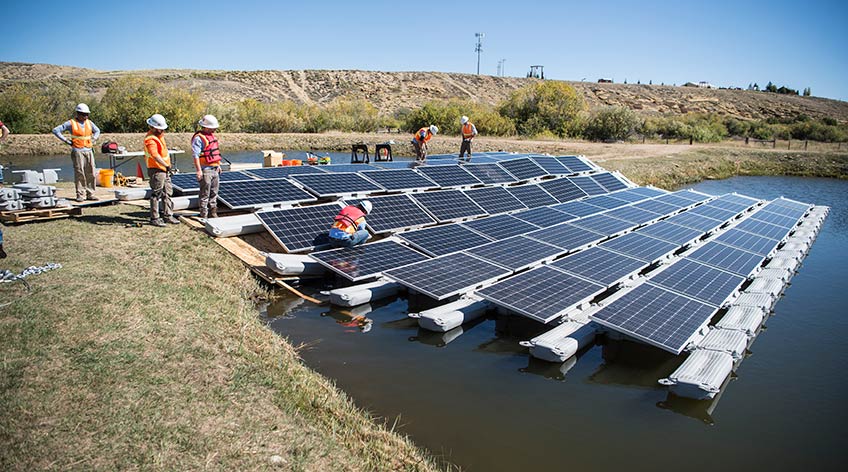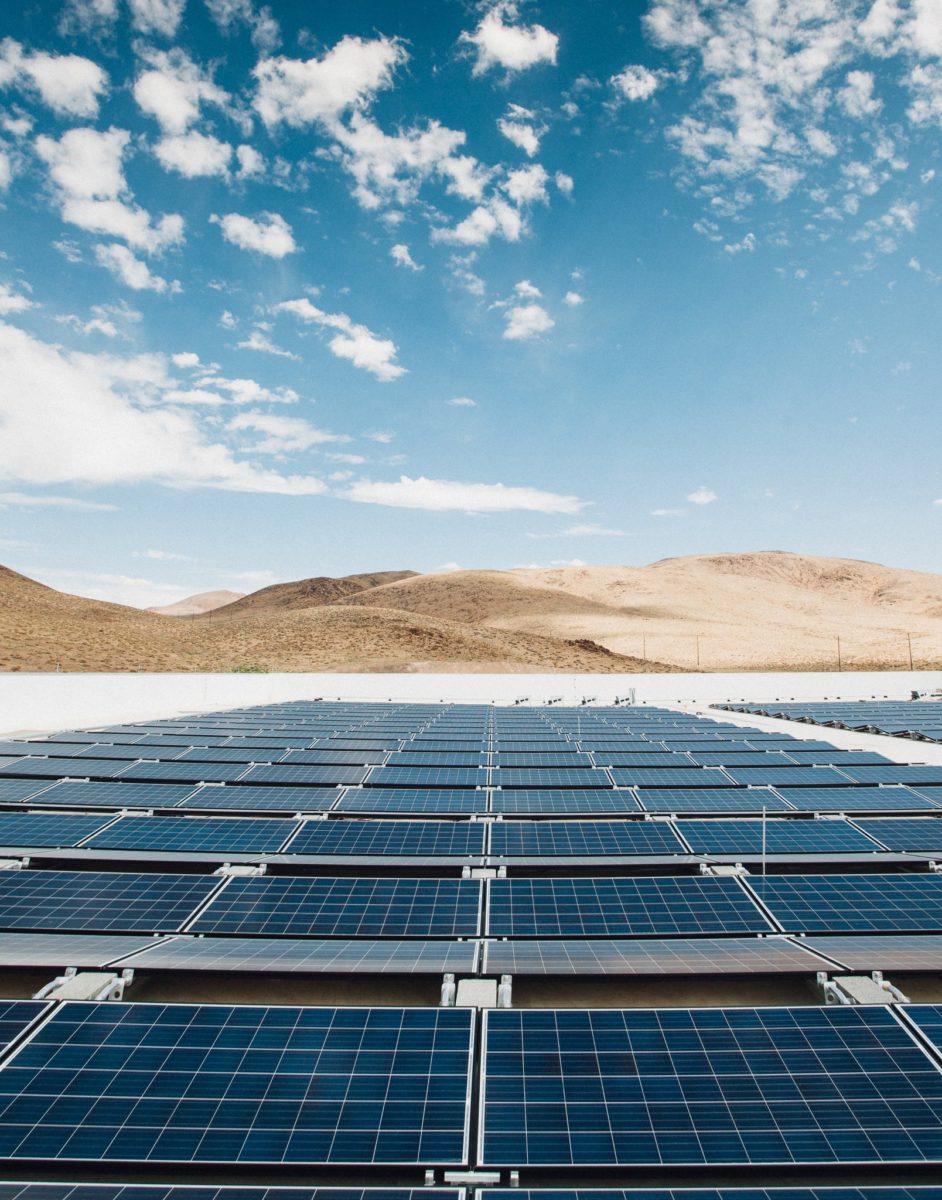Everybody has that one argument, one point, one opinion, the thing that nobody is asking about, but it consumes you. It’s not unhealthy, it’s just so unrealistic that you harp on it, because if it ever did happen you’d get to say “I told you so,” and there’s absolutely no phrase more satisfying.
For this writer, it’s allowing NFL players to participate in Olympic Rugby, so that the U.S. could dominate for gold every four years, for Elon Musk, it’s converting 100 square miles of the Arizona desert into a solar project with enough capacity to power the country. It’s an old argument of Musk’s, but one he brings up frequently.
He’s def wrong. Solar power is a Gigawatt per square km! All you need is a 100 by 100 mile patch in a deserted corner of Arizona, Texas or Utah (or anywhere) to more than power the entire USA. This analysis goes through calcs https://t.co/fI1I452tm6
— Elon Musk (@elonmusk) December 7, 2019
It’s also an argument that, as ludicrous as it sounds and logistically flawed as it is, is technically possible – the best kind of possible. Musk’s supermassive solar project would require a patch of land measuring 10,000 square miles, with an accompanying battery in the one square mile ballpark.
Assuming the use of 24% efficient modules across the entire project, researchers at University College London found that even under conservative figures (100×100 kilometers instead of miles), projection would feasibly work. 10,000 square kilometers, multiplied by 0.24 GW per square kilometer, multiplied by 0.21 comes out to around 500 gigawatts. By comparison, the country’s annual electricity consumption rate was 425 gigawatts as of 2013, when this test was conducted.
In reality, there’s a difference between a possibility and a solution. What Musk is providing is a possibility. We could cover 10,000 square miles of desert in solar panels, but an entirely centralized national power supply leaves the country vulnerable to continental outages in the event of a storm or cyber attack. While catastrophic storms aren’t common in the desert and the energy grid has never sustained anything near that high-level of an attack, why even pose the risk? THis is even before going into the regulatory and permitting sleep paralysis nightmare that would be securing land and public/government approval for the project.
But you know what? Now that we’re talking about it, is there a more feasible way to entirely power the country with solar energy?

Making the impossible a reality
In 2017, a group of researchers from Michigan State published a paper suggesting that the United States could get 40% of its electricity from solar windows. Their projection suggested 5 to 7 billion square meters of usable window space existed, and that a 15% efficient solar window product applied across the area would get close that 40% number. The team was then awarded a $1.3 million grant to further develop its organic solar cell window technology. By April 2018, they were already hitting 15% with their organic solar cells, and projected 18% soon to come.

So, if we could hit 18% and cover all our windows with solar, that 40% value noted above would grow by 20% – meaning that perfect United States would get its first 50% of electricity from 5-7 billion square meters of solar power collecting windows.
Next, enter the Energy Department’s National Renewable Energy Laboratory (NREL). In 2016, researchers at the lab:
used detailed light detection and ranging (LiDAR) data for 128 cities nationwide, along with improved data analysis methods and simulation tools, to update its estimate of total U.S. technical potential for rooftop photovoltaic (PV) systems. The analysis reveals a technical potential of 1,118 gigawatts (GW) of capacity and 1,432 terawatt-hours (TWh) of annual energy generation, equivalent to 39 percent of the nation’s electricity sales.
This report notes that the above values are based on a 16% efficient solar module, and that if modules increased to 20% efficiency (or 21.7% if you’re REC), then that 39% number would grow by 25% to 48.75% of the US annual electricity demand value.
So, just based on roofs and windows alone, we’re at 98.75%, not a bad start.

Then, late last year, NREL came back to say that the U.S. technical potential for floating PV, described by NREL as a “rapidly emerging technology,”at 2100 gigawatts, which could generate 9.6% of current electricity generation (before we upsize for module efficiency gains).
The methodology behind this estimation began with a dataset of all man-made reservoirs, with those used for recreation, navigation, fish and wildlife, those located more than 50 miles from a transmission line and small water bodies removed from the set. Of the remaining reservoirs, NREL assumed that 27% of the surface area could be covered with floating PV, based on the median coverage value of existing floating PV projects. The projection also assumed the technical factors of a fixed tilt angle of 11 degrees and a capacity density of 10,000 square meters per megawatt, both of which are common among existing floating PV projects.
So, using all of the resources listed above, we could hypothetically reach 108.35% of the nation’s current electricity demand, all without retro-forming 10,000 square miles of desert into the largest power project ever conceived. This is all before we consider any land solar or parking lot solar. For some quick math, a parking spot can hold about 9 solar modules, if they’re 400 watts each, and we can use half of the roughly 2 billion parking spots in the country – that’d total about 3.6 TW of solar capacity. This might conservatively 5,000 TWh/year – which would all on its own cover US’ approximate usage of 4,000 TWh/year.

This content is protected by copyright and may not be reused. If you want to cooperate with us and would like to reuse some of our content, please contact: editors@pv-magazine.com.









The future is homes, building, etc behind the meter/btm, making their own mostly solar but small wind, CHP/CSP, heat/cold storage and bio/waste, syngas batteries and EVs with V2G.
Why is simple, energy for under $.05/kwh retail. Vs $.10-.50/kwh from the grid.
In 20 yrs likely 60% of power plus will be made btm yet almost no one is taking it into account.
Every time I fly in over a city, I look down on all those large, flat, unshaded rooftops and think “Why are they not covered with solar panels?”.
I am all for solar power, I have a system on my house and have not paid an electric bill since July 2018. Arizona has lots of land that is wasted space. Maybe if a 100 X 100 mile area is to big why not reduce the size to four 25 X 25 mile area’s. They just closed down the big coal fired generating plan in Northern Arizona why not convert that area to a giant solar plant? The utility electric lines are still in place for the generator plant. Plus it would give jobs to the Navaho Nation’s Indian population.
Wasted space… what about the natural environment? I too am for solar and if it had to come to massive plots of land becoming developed, better to spread it out amongst the sunniest states rather than just one massive solar farm.
50 states, 2 square miles, even 10x it’s still acceptable. Heck landfills alone would go a long way.
Robert: Navajo Nation is looking at just that, and they have some interested investors.
Sixteen 25 X 25 mile areas.
The pint is that this is the total size of the panels and storage needed. It does not have to be all in one place. He used that graphic to show how small there area needed is to accomplish this. There is not need to hae it all in one place, it can be distributed across the nation. The total is what matters.
Hello Bob. We know he doesn’t literally want to buy up a square in Arizona and put the nation’s entire energy supply there, but by not stating that and also listing the issues with doing so, I see how it totally appears that we do. Apologies for not being clear. We also just wanted to point out how very little of it has to be done using the traditional utility model and show the variety of ways his point is correct.
Have you written on this subject since 2019? Have you looked at the electrical energy needed to run ALL transportation using EV’s? Have you seen a similar solar panel analysis to yours, but includes EV’s? Thank you.
I got an e-mail about a comment from “Bob” asking if someone had written about this at all since 2019, apparently skeptical of the space requirements. I actually did this a couple of weeks ago for wind. It is tricky. There are a lot of pitfalls. Let’s agree that figuring out the requirement for total U.S. land for wind or solar isn’t advocating 100% wind or 100% solar. I believe the economic optimum will be somewhere around 70% wind and 30% solar, but there are far too many variables to do more than assert that as a reasonable discussion point in 2022.
The answer was that to produce all the electricity the U.S. uses solely from wind using 2021 data, is 3.7% of the dry land in the U.S. Bear in mind that 30% of the U.S. is desert and 30% is agricultural land. Wind is an ideal companion to agriculture because it only physically requires 1.8% of that space, which is four one-hundredths of one percent of the land that will actually have wind equipment on it.
This calculation was done using the actual output of the U.S. wind fleet in 2021. It would be slightly less turbines if we used taller towers, improve the efficiency, and optimize a few things, but the space would be similar. If we use offshore wind, like offshore solar, it will be more expensive, but perhaps not much, and relative to fossil and nuclear costs it might still be a savings.
I haven’t tackled solar spacing carefully, but it’s on my list. Of course, a certain fraction of additional space will be needed to compensate for energy losses during storage. That looks to be easily affordable given today’s efficiencies of storage. And the right balance of wind plus solar needs a great deal less storage than either alone.
Elon wasn’t actually proposing that we convert land in Arizona to a solar field, he was just demonstrating how much space it would take because some people seem to think there isn’t enough space. It’s implied that solar panels would go on rooftops and other places, lol.
Why do floating solar panels have to be fixed in orientation? I looks quite possible to instal them on floats that can rotate to some extent, providing a measure of tracking over the day, and giving a worthwhile boost to shoulder output.. Call it “half-axis tracking”.
4 Dry Lakes in California and Nevada Take Us 90% of the Way There —
El Dorado Dry Lake — 20 square miles
Ivanpah Dry Lake — 13 square miles
Rosamond Dry Lake — 14 square miles
El Mirage Dry Lake –43 square miles
That’s the deal, within the argument. I think it was the DOE who funded a study of roofs in the U.S. that are acceptable for solar PV installation. I want to say the number was viable roofs were at 100,000,000 in the U.S.. We need to remember that some of those roofs are very large, like big box stores, commercial buildings like malls, Industrial buildings and warehouses have a lot of square feet of panel space that could be on those roofs also. Solar PV is the most efficient when installed on the roof of the building using the energy. It would also be the most efficient to use an energy storage system to benefit more from the solar PV generation everyday. Distributed solar PV is better used in a micro-grid than as a (replacement) of say a coal fired plant.
FERC had a pretty good graphic up at one time. It showed the actual power in to power out loss from the generation input to the ratepayers home’s power to use. Coal fired and even natural gas fired plants using the heat steam cycle to generate power lose about 40% of the power input of burning a fuel. Another 10% in friction losses and about 6% for step up power losses going through transformers to get the correct voltage to put on the grid distribution system. After that there are on average 3% power losses for every transformer step the generated product goes through. One can lose from end to end, right around 80% of the power input, usually stated as BTUs. Just the transformer losses themselves can be from 12% to 25% getting the power to the homeowner’s 240VAC circuits. When one replaces a coal fired plant with solar PV or wind generation, these obnoxious step transformer losses are still in play. I submit, 100 x 100 miles of solar PV arrays would be more like 200 x 200. This would be for domestic use only. Transportation and heating is another “demand chain” that hasn’t been addressed. If you go by the EIA yearly energy estimates for the U.S., we are looking at about 3.4 TWh of energy a day. With current technology you’re looking at something like maybe 600 x 600 miles, with weather events one might need three times this generation capacity online or 1800 x 1800 miles. The U.S. is only 3.8 million square miles. One needs much more efficiency or much more power density.
why not store the energy on site and move it off site to a substation using superconducting material.
The collected energy should have close to 100% transfer….of course , every component must be replaced for this type of tehcnology.
“You are right…..I was told half the power generated at a dam is lost in transmission ( 1000km ), and as you say, even more, is lost on its way to being used. I guess we can be cavalier about it, since the dam doesn’t stop producing.”
Does anyone know how much Natural Gas power (not used in utility electricity) will need to be replaced by 2030 to reduce emissions? How much oil-based power?
Why look to replacing current utility fossil fuel power demand as Victory? It may be only half the way to clean air.
Lance, I agree: the grid is only half the problem. The electric grid is getting all the attention, and PV is hot right now and likely going to keep expanding until it takes over the electricity sector, so Im not really worried about that.
But from what i can see, there is not as much happening on the natural gas side. Most homes are heated with gas, have gas stoves, and gas water heaters. These can be replaced on an individual basis with rooftop solar thermal collectors, whether hot air or hot water, but this sector of the solar business is not achieving anywhere near the market share that PV is. Another option is the “electrify everything” approach including hot water, stoves, and electric space heating (baseboard heat, or heat pumps.) This electrify-everything approach would drastically increase the demand on the electric grid, doubling the amount of PV needed. Worse, heating demands occur at night, making grid-scale battery storage even more challenging. Rooftop thermal collectors seem like the right answer.
And then, theres the cars…
As electric cars become more common the need for more electric power needs to grow. If you take the power generated by gasoline that is used to power today’s cars and assumed that over time all cars will be electric the scope of the whole electric growth requirement comes into vision.
Also, rather than put all that generation in one spot it would be better to spreed it around the entire country. It reduces the possibility of a massive failure and lowers the transmission losses which are very significant today and would only become worst with a single centralized approach.
What if we were to provided solar panels to every home and building in the U.S.?Does it anyone knows of a study like that?
I hope someone can get Bill Gates’ attention long enough to stop him making all those mistakes. Efficiency, wind and solar – three technology groups. All three cost about half as much as fossil or nuclear generation, thanks mostly to the 40% drop in cost of wind and solar since 2018.
I have done extensive examination of wind output, using actual generation data per hour for the entire year of 2017 from MISO. When wind produces 50% of the electricity in MISO, 0.7% of it will be above consumption. The current cost of wind in MISO is so cheap that the wind generators can easily afford to generate 70% of MISO’s load from wind, with a wastage of slightly more than 9%, but there will be a healthy market for that “dispatchable load”.
Total U.S. electricity can be served by solar using about 1.5% of total land in the U.S. Let’s get over the arrogance, Arizona, it won’t be your 1.5%. Yes Arizona has the best solar, but the difference between Arizona and Maine is 40%, and it is cheaper today to build solar in Maine than to transport it from Ohio, let alone Arizona. Solar alone requires a lot of storage, but wind plus solar requires less than 20% of total consumption be stored, and we already have 10% of our existing supply in the form of dispatchable renewables. Geothermal, biomass and hydropower.
Personally, I favor using that excess wind (and solar, when we have enough solar to have excess) to produce hydrogen, which can be stored in existing natural gas storage facilities and used in existing natural gas combined cycle plants. I think that is the storage technology that beats all others, unless it turns out to be cheap enough to convert the electricity to renewable methane. I’m still working on a modern assessment of the cost – as are a lot of other people (google Carbon Engineering). With abundant wind and solar under 2 cents per KWh, this is a completely different conversation than the one we might have had five years ago, and a lot of people are still using data from ten or fifteen years ago.
Wind and solar are cheaper than fossil fuels. (Google wind 74% and see the article. It doesn’t say that by being cheaper than coal, wind is also cheaper than natural gas and nuclear, in about the same percentage. It correctly says that the number will rise (they say to 86% by 2025). It doesn’t say that this is the cornerstone of an economic revolution which will last longer than climate change does, because it will change the way people think about eachother. When you live in a world of abundance, things look very different than they do in a world of shortage and control
I just watched a video on perovskite solar a couple days ago (channel: Just Have a Think). These are hitting 29% efficiency in the lab after only about a year of research. It sounds like it is possible to make a 3 junction cell to optimize the capture of low, medium, and high frequency light. The materials and energy required to make perovskite solar should be cheaper than silicon-based panels. Even if research only optimized their efficiency to 30% for a cheaper / similarly priced panel to existing, this would have a massive effect. Besides reducing required area and potentially cost as well, higher efficiency opens up more possibilities….Electric cars covered in 30 to 35% efficiency panels might not need to be plugged in very often you park in the sun and have a 20 to 30 mile (or less) commute. At least under coronavirus shelter in place, even 20% efficiency panels on my car’s roof and hood would keep me at 100% battery (only driving 200 to 300 miles per month, max). A premium panel with 40% efficiency would make sun-powered cars more feasible for a much wider array of usage patterns.
Especially when combined with 220 to 250 mile range batteries. 50 mile round trip commute (above US average of 30)…Regen 20 to 25 miles from car’s solar PV. Deficit of 25 to 30 miles per day…less driving on weekends… instead of needing to plug-in every 4 days (at least), maybe plug-in every 10 to 12 days. If post-coronavirus business still allows a day or two of work from home per week, you could “go infinite”
What would it cost?
Including retrofitting transmission lines.
Since the world seems to be going for a for “lease/rent ” approach….you know, why buy a car, when you can just hail Uber or “rent for what your need…..
What if we “rent” the plan from ourselves. If there is a cost, and nations are willing to defer their military spending till it gets built…..is it doable. Can we implement this, and make it sustainable through our contribution to the “plan ”
Ok, maybe I didn’t articualte it well enough. As a country, collevtively, it can be dome by managing our contributions more responsibly. It would be built quickly and possibly financed even quicker through a combination of factors.